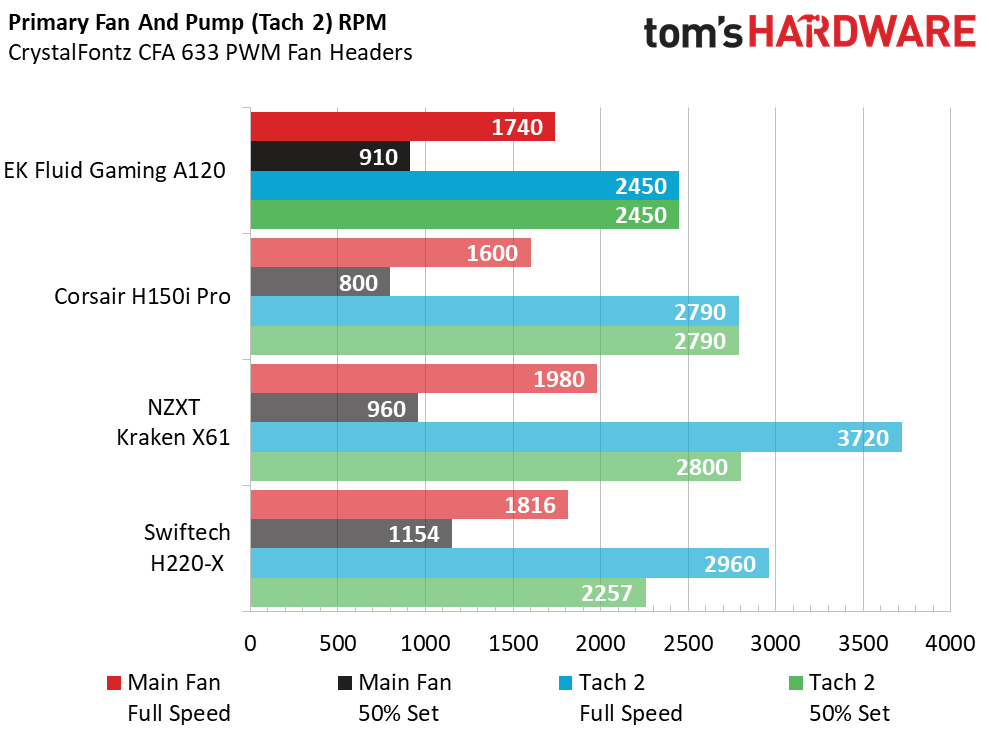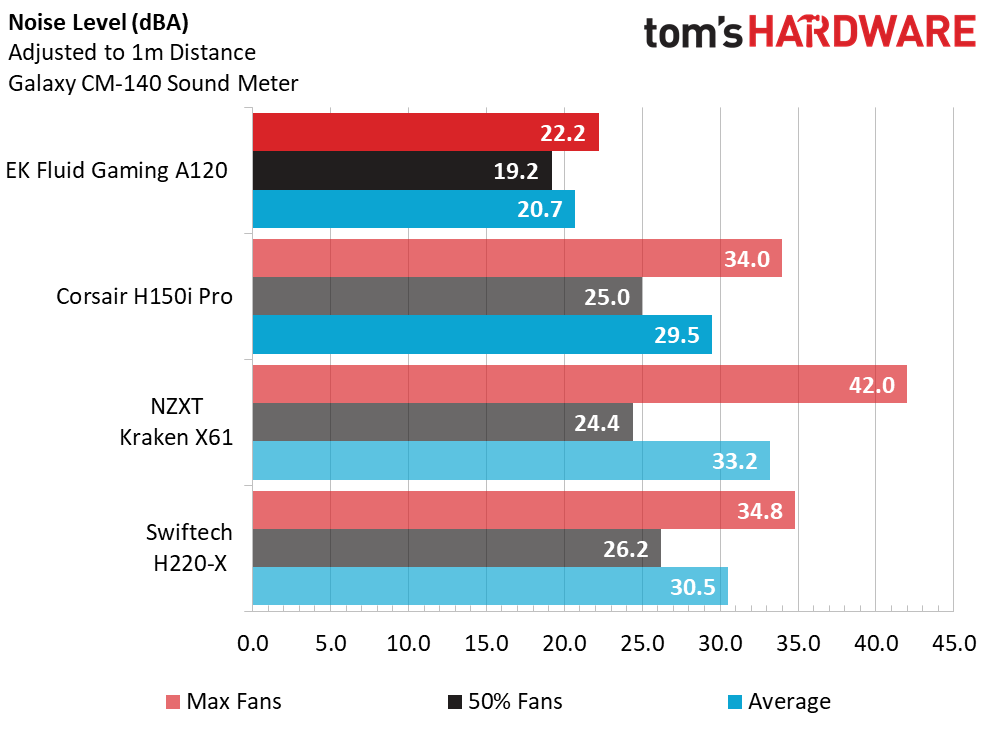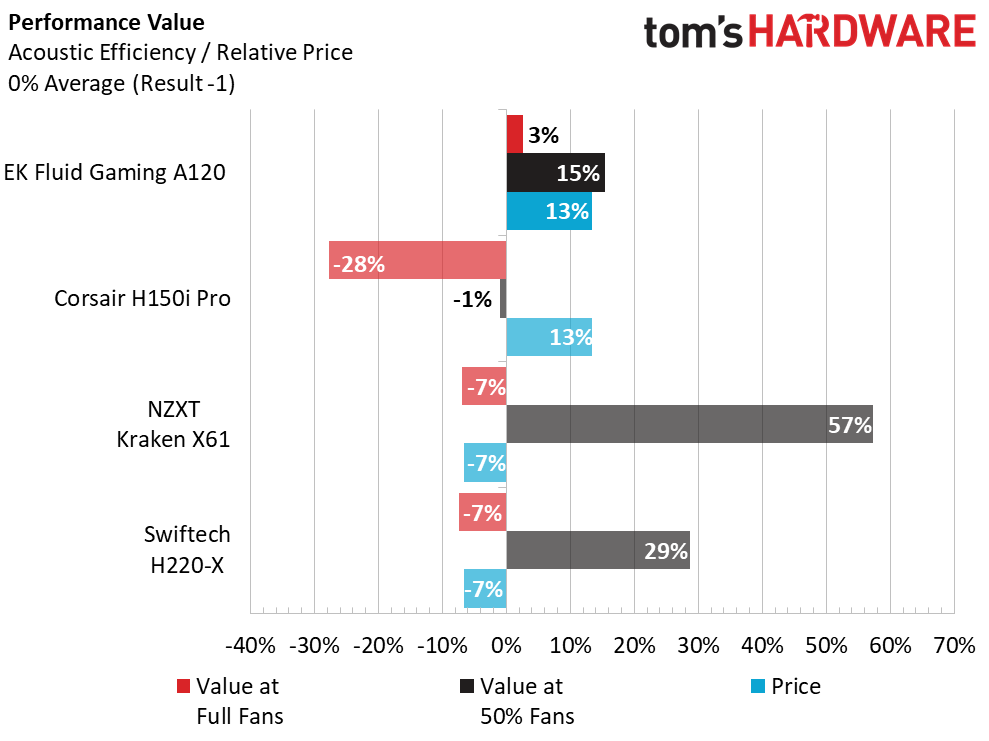EK Fluid Gaming A120 Kit Review: Nifty CPU Cooler For Liquid Novices
Why you can trust Tom's Hardware
Testing Results & Conclusions
Our comparison tests are derived from current and prior CPU-cooler testing using standardized methods for benchmarking and gathering data. We performed all the tests on our hexa-core Intel Core i7-5930K CPU, running at 4.2GHz. We will be comparing the results from the EK Fluid Gaming A120 against other liquid coolers similar in retail price: the Corsair H150i Pro, the NZXT Kraken X61, and the Swiftech H220-X.
Our thermal load test provides immediate insight into the single largest shortcoming of the Fluid Gaming A120 kit: It is the only cooler in our comparison group that uses a single-fan 120mm radiator. The large 280mm radiator on the NZXT cooler even manages to do better than the one on the Swiftech H220-X, one of the most cost-effective AIO expandable coolers. Another interesting detail: The EK A120 is the only cooler of this lot with an aluminum CPU block. All others use copper, which is far denser and more thermally conductive, to wick heat away from our processor.
EK has provided a single 1850 RPM Vardar fan for cooling the fins of the 120mm Alustream radiator, and we observed a maximum speed of 1740 RPM, which is very respectable when pushing air through restrictive cooling fins. Rotational speeds of all fans in the test group showed similar readings, which should produce some interesting noise-level readings.
One benefit to a single-fan design: Often, the measured relative noise levels are lower than those of other coolers with more fans. Here, the almost inaudible EK Fluid Gaming A120 easily bests the rest of the coolers in the group. Another benefit of the pump and cooling fan being at literal opposite locations in the case (top vs. bottom) is the offset of ambient noise from both components. The slight hum of the pump at full power is barely audible, even in the immediate vicinity.
Such low noise readings often mean good results on our Acoustic Efficiency measure, and the EK A120 shows that being almost completely silent does have value when compared to cooling ability. While it doesn’t match the raw cooling ability of the Kraken X61, the Fluid Gaming A120 does go about its work without much fuss.
Our overall Performance Value rating illustrates some strong showings across this comparison group. Average pricing across all of the coolers here is right at $150, which also happens to be the MSRP for the EK Fluid Gaming A120 kit itself. It also happens to be the only cooler of this test group to turn in a positive value rating at both full-speed and half-speed fan settings. The loud fans of the NZXT Kraken X61 prove to be a detriment, when it’s all said and charted.
Final Thoughts & Conclusion
So, what have we learned about the EK Fluid Gaming A120 kit?
Get Tom's Hardware's best news and in-depth reviews, straight to your inbox.
For one thing, we really would have liked this kit to have instead included a 240mm (2x120mm) radiator. Liquid cooling isn’t a pre-requisite for overclocking, but for big processors or highly clocked CPUs, a single 120mm radiator often will struggle with keeping CPU core temps down, even with excellent fans attached. The pump provided for the kit was a real highlight, however, and we were impressed with how quietly it ran while providing high coolant flow rates.
EK has taken a real chance by going against the "flow" of liquid-cooling doctrine and providing a solution here engineered in aluminum. As long as you follow all warnings and do not introduce mixed metals into your cooling loop, the EK Fluid Gaming A120 should serve you well. It's also a great base kit for the novice to liquid cooling.
MORE: Best CPU Cooling
MORE: How To Choose A CPU Cooler
MORE: All Cooling Content

Garrett Carver is a contributor for Tom’s Hardware, primarily covering thermal compound comparisons and CPU cooling reviews; both air and liquid, including multiple variations of each.
-
Olle P Reply...we really would have liked this kit to have instead included a 240mm (2x120mm) radiator...
As even your link show there is such a kit available. That's not the product you tested, and therefore totally off the point.
I also can't understand why the performance wasn't compared to some of the 120mm AIOs available on the market instead of these much larger ones that must be seen as a non option (due to size limitations) for anybody buying this kit.
With a smaller convector the cooling is expected to be less impressive. -
jpe1701 I understand you are going by price parity, but a couple competing 120mm products would have been nice to see in the comparison. Good review though, thank you. I have always wondered though about this product. I would have to think that someone willing to spend that much for liquid cooling would have planned and got a case that would fit larger than a 120mm rad and not many of these would get sold. And enthusiasts would know if you were stuck using a 120mm rad, use a thicker one for more surface area. Idk, just my 2 cents.Reply -
abbeytim https://www.ekfluidgaming.com/ek-kit-a240 $159.99 why pay 149.99 for a single rad lolReply -
rubix_1011 Reply20934900 said:Can an all-aluminum liquid-cooling kit provide enough performance to satisfy demanding performance enthusiasts?
EK Fluid Gaming A120 Kit Review: Nifty CPU Cooler For Liquid Novices : Read more
20937258 said:...we really would have liked this kit to have instead included a 240mm (2x120mm) radiator...
As even your link show there is such a kit available. That's not the product you tested, and therefore totally off the point.
I also can't understand why the performance wasn't compared to some of the 120mm AIOs available on the market instead of these much larger ones that must be seen as a non option (due to size limitations) for anybody buying this kit.
With a smaller convector the cooling is expected to be less impressive.
Yes and no, but let me explain a bit.
Editorial does most of the links to other products, and yes, there is a 240 version of this kit, which is the basis of where my 'wishing' originates. I would have liked to see the base kit be a 240 rather than a 120 because of the exact limitation on cooling you mention. Also, the cost delta between the 120 and 240 kit also is going to be very minimal, assuming all other components are equal between them.
I liked the entire kit overall, and the build quality of the components is the same EK quality you'd expect...It is just that while this is meant to be a beginner's kit, it still requires the larger footprint that a full watercooling loop demands, which doesn't exactly place it in the same category as a 120 AIO.
Another reason why this wasn't directly compared to other 120mm AIOs is due to cost - most 120 AIOs are firmly in the $50-$100 range (at the very upper end) which still falls about $50 short, by comparison.
There is also the issue that we have not received any newer 120mm AIOs to test recently - The Kraken M22 arrived shortly after this was tested and written. Most AIOs we've been receiving for testing (that are also current/relevant product stock) are 240 and 360 AIOs. -
rubix_1011 Reply20937668 said:Can you switch to hard tubing? and color solutions on this kit or the 240?
You could, yes, but it would require swapping out the fittings to use hardline fittings. These are also typically brass, which would counter the use of using all aluminium in the cooler design and make it prone to galvanic corrosion.
While there is not any RGB lighting options, you could always add your own. You could also add color dyes or coolants, if you wished. -
mlee 2500 Can anyone recommend a good primer/introductory overview for open loop cooling?Reply
I've been building PC"s since '89....both professionally and personally I imagine several hundred by this point....but aside from a few closed-loop components I haven't really gotten into liquid cooling.
My interest is almost entirely in the pursuit of building a QUIET computer rather then overclocking to achieve performance above "stock high end". That is, I tend to buy top of the line CPU's and Graphics cards but run them at factory settings (I play strategy games at high resolution, not so much FPS...squeezing an extra 5%-10% performance isn't THAT important to me personally...certainly not enough to warrant the extra heat or risk instability).
In terms of closed loop systems, the current state of the art doesn't really seem to save you too many decibels, and in fact a pretty good argument can be made that internal Air Coolers are still the best route if you want quiet without serious overclocking.
Does that equation change if you move to Open Loop cooling? And if so, what are the pratfalls someone new to open-loop should avoid?
Thanks in advance for your thoughtful comments. -
rubix_1011 I wrote the watercooling sticky hosted on the forums, if you wish to take a look (linked in the Overclocking, Cooling & Watercooling MetaIndex linked in my signature line below).Reply
The biggest noisemakers for liquid cooling are fans, and if you opt to use 140mm radiator sizes, this helps increase your cooling surface area and also often lowers your noise levels, since 140mm fans run slower and quieter than 120mm versions.
In short, yes, you can get very quiet watercooling builds if you wish, but it really depends on matching fans and radiators more than anything else. Pumps are typically very quiet during operation. -
mlee 2500 Thanks Rubix, I'll check it out!Reply
I found guru3d.com reviewed the 240mm version of this EK cooler, and even with a GTX 1080 added to the loop, they seem to have achieved much better results.
It's a pretty detailed review (and guide, really) which makes me think this kit might be a good first real LC build for me.
You know, the Radiator/Fan relationship you describe seems to be the same for closed loop components...if there were decent off-the-shelf closed loop coolers for GTX Video Cards then I might never feel compelled to mess with open loop systems. But there isn't....just a couple of very marginal solutions in that space, so it seems that if you want to quiet that blower in your machine you kinda have to fully commit to an open loop system.







